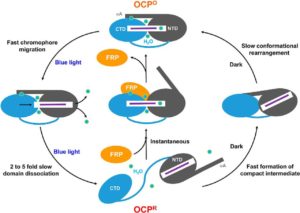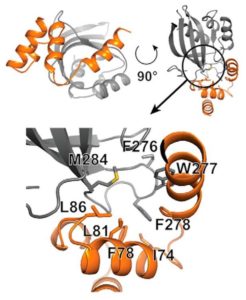
Working model of photoprotection by the OCP.
Under high-light conditions, photosynthetic organisms engage protective mechanisms to dissipate excess energy and prevent oxidative damage that would otherwise lead to cell death. Cyanobacteria use the orange carotenoid protein (OCP) to trigger photoprotection of their extramembrane antenna complexes, effectively reducing the amount of energy transferred to the photochemical reaction center. In low light, the OCP relaxes to its native state, a process that is accelerated in the presence of fluorescence recovery protein (FRP). Understanding the switching on and off of thermal dissipation–and the action of the “photoswitch” which controls this mechanism–has implications in synthetic biology, such as the finer control of photoprotection and consequent enhancement of photosynthetic efficiency.

The major interface of the OCP C-terminal domain (gray) and FRP monomer head domain (orange) form a complex. The zoomed region shows the highly hydrophobic binding interface and residues that undergo significant protection upon complex formation.
Researchers at Berkeley Lab and Michigan State University (MSU), led by Corie Ralston and Cheryl Kerfeld, performed X-ray footprinting mass spectrometry (XFMS) experiments at the Advanced Light Source (ALS) beamline 5.3.1, which revealed new mechanistic details of the key events in OCP photoprotection. XFMS is ideally suited to probing conformational dynamics at the single residue level, providing both a spatial and temporal view of site-specific changes in the OCP and its interaction with the FRP. The experiments showed that FRP provides an extended binding region that holds the OCP together and forces proximity of the two domains that accelerate relaxation of OCP to its native state.
The results were published in the Journal of Biological Chemistry. In addition to Ralston, a staff scientist in Molecular Biophysics and Integrated Bioimaging (MBIB), and Kerfeld, an affiliate faculty scientist in Environmental Genomics and Systems Biology (EGSB) and professor in the MSU-DOE Plant Research Laboratory, the paper’s authors included: from MBIB, Sayan Gupta, Soumya Remesh, and Ashlee Feng; from EGSB, Markus Sutter; and from the Joint BioEnergy Institute (JBEI) and Biological Systems and Engineering (BSE), Leanne Jade Chan and Christopher Petzold.




